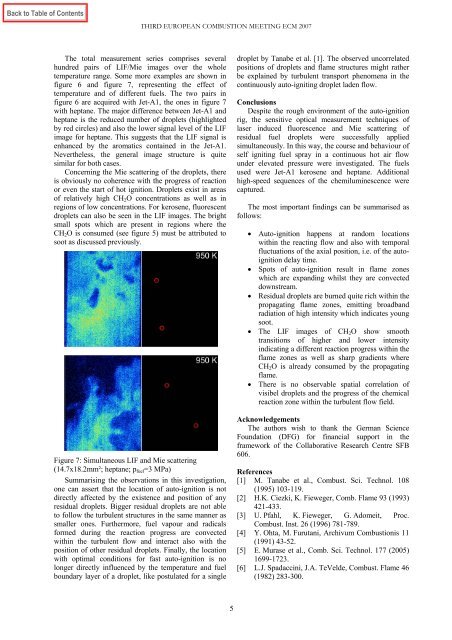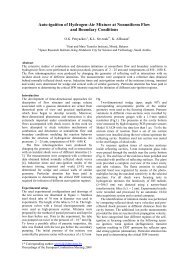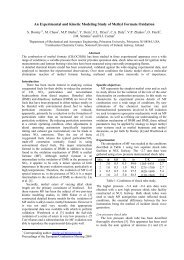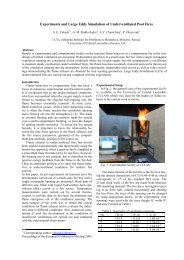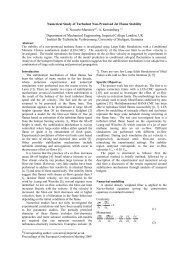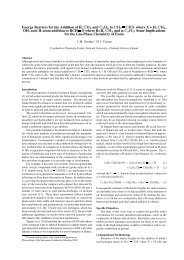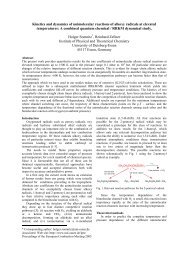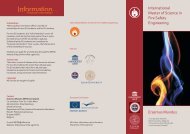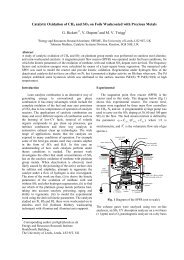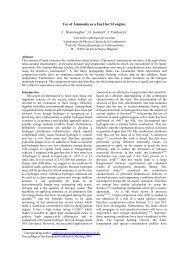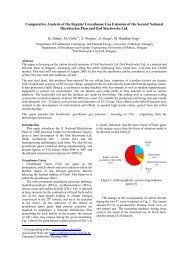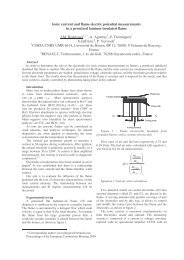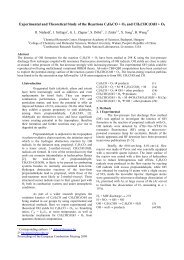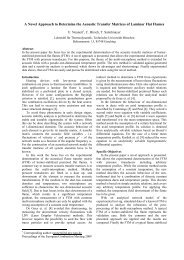Laser based study of auto-ignition of sprays in a continuous flow ...
Laser based study of auto-ignition of sprays in a continuous flow ...
Laser based study of auto-ignition of sprays in a continuous flow ...
Create successful ePaper yourself
Turn your PDF publications into a flip-book with our unique Google optimized e-Paper software.
THIRD EUROPEAN COMBUSTION MEETING ECM 2007<br />
The total measurement series comprises several<br />
hundred pairs <strong>of</strong> LIF/Mie images over the whole<br />
temperature range. Some more examples are shown <strong>in</strong><br />
figure 6 and figure 7, represent<strong>in</strong>g the effect <strong>of</strong><br />
temperature and <strong>of</strong> different fuels. The two pairs <strong>in</strong><br />
figure 6 are acquired with Jet-A1, the ones <strong>in</strong> figure 7<br />
with heptane. The major difference between Jet-A1 and<br />
heptane is the reduced number <strong>of</strong> droplets (highlighted<br />
by red circles) and also the lower signal level <strong>of</strong> the LIF<br />
image for heptane. This suggests that the LIF signal is<br />
enhanced by the aromatics conta<strong>in</strong>ed <strong>in</strong> the Jet-A1.<br />
Nevertheless, the general image structure is quite<br />
similar for both cases.<br />
Concern<strong>in</strong>g the Mie scatter<strong>in</strong>g <strong>of</strong> the droplets, there<br />
is obviously no coherence with the progress <strong>of</strong> reaction<br />
or even the start <strong>of</strong> hot <strong>ignition</strong>. Droplets exist <strong>in</strong> areas<br />
<strong>of</strong> relatively high CH 2 O concentrations as well as <strong>in</strong><br />
regions <strong>of</strong> low concentrations. For kerosene, fluorescent<br />
droplets can also be seen <strong>in</strong> the LIF images. The bright<br />
small spots which are present <strong>in</strong> regions where the<br />
CH 2 O is consumed (see figure 5) must be attributed to<br />
soot as discussed previously.<br />
Figure 7: Simultaneous LIF and Mie scatter<strong>in</strong>g<br />
(14.7x18.2mm²; heptane; p fuel =3 MPa)<br />
Summaris<strong>in</strong>g the observations <strong>in</strong> this <strong>in</strong>vestigation,<br />
one can assert that the location <strong>of</strong> <strong>auto</strong>-<strong>ignition</strong> is not<br />
directly affected by the existence and position <strong>of</strong> any<br />
residual droplets. Bigger residual droplets are not able<br />
to follow the turbulent structures <strong>in</strong> the same manner as<br />
smaller ones. Furthermore, fuel vapour and radicals<br />
formed dur<strong>in</strong>g the reaction progress are convected<br />
with<strong>in</strong> the turbulent <strong>flow</strong> and <strong>in</strong>teract also with the<br />
position <strong>of</strong> other residual droplets. F<strong>in</strong>ally, the location<br />
with optimal conditions for fast <strong>auto</strong>-<strong>ignition</strong> is no<br />
longer directly <strong>in</strong>fluenced by the temperature and fuel<br />
boundary layer <strong>of</strong> a droplet, like postulated for a s<strong>in</strong>gle<br />
droplet by Tanabe et al. [1]. The observed uncorrelated<br />
positions <strong>of</strong> droplets and flame structures might rather<br />
be expla<strong>in</strong>ed by turbulent transport phenomena <strong>in</strong> the<br />
cont<strong>in</strong>uously <strong>auto</strong>-ignit<strong>in</strong>g droplet laden <strong>flow</strong>.<br />
Conclusions<br />
Despite the rough environment <strong>of</strong> the <strong>auto</strong>-<strong>ignition</strong><br />
rig, the sensitive optical measurement techniques <strong>of</strong><br />
laser <strong>in</strong>duced fluorescence and Mie scatter<strong>in</strong>g <strong>of</strong><br />
residual fuel droplets were successfully applied<br />
simultaneously. In this way, the course and behaviour <strong>of</strong><br />
self ignit<strong>in</strong>g fuel spray <strong>in</strong> a cont<strong>in</strong>uous hot air <strong>flow</strong><br />
under elevated pressure were <strong>in</strong>vestigated. The fuels<br />
used were Jet-A1 kerosene and heptane. Additional<br />
high-speed sequences <strong>of</strong> the chemilum<strong>in</strong>escence were<br />
captured.<br />
The most important f<strong>in</strong>d<strong>in</strong>gs can be summarised as<br />
follows:<br />
• Auto-<strong>ignition</strong> happens at random locations<br />
with<strong>in</strong> the react<strong>in</strong>g <strong>flow</strong> and also with temporal<br />
fluctuations <strong>of</strong> the axial position, i.e. <strong>of</strong> the <strong>auto</strong><strong>ignition</strong><br />
delay time.<br />
• Spots <strong>of</strong> <strong>auto</strong>-<strong>ignition</strong> result <strong>in</strong> flame zones<br />
which are expand<strong>in</strong>g whilst they are convected<br />
downstream.<br />
• Residual droplets are burned quite rich with<strong>in</strong> the<br />
propagat<strong>in</strong>g flame zones, emitt<strong>in</strong>g broadband<br />
radiation <strong>of</strong> high <strong>in</strong>tensity which <strong>in</strong>dicates young<br />
soot.<br />
• The LIF images <strong>of</strong> CH 2 O show smooth<br />
transitions <strong>of</strong> higher and lower <strong>in</strong>tensity<br />
<strong>in</strong>dicat<strong>in</strong>g a different reaction progress with<strong>in</strong> the<br />
flame zones as well as sharp gradients where<br />
CH 2 O is already consumed by the propagat<strong>in</strong>g<br />
flame.<br />
• There is no observable spatial correlation <strong>of</strong><br />
visibel droplets and the progress <strong>of</strong> the chemical<br />
reaction zone with<strong>in</strong> the turbulent <strong>flow</strong> field.<br />
Acknowledgements<br />
The authors wish to thank the German Science<br />
Foundation (DFG) for f<strong>in</strong>ancial support <strong>in</strong> the<br />
framework <strong>of</strong> the Collaborative Research Centre SFB<br />
606.<br />
References<br />
[1] M. Tanabe et al., Combust. Sci. Technol. 108<br />
(1995) 103-119.<br />
[2] H.K. Ciezki, K. Fieweger, Comb. Flame 93 (1993)<br />
421-433.<br />
[3] U. Pfahl, K. Fieweger, G. Adomeit, Proc.<br />
Combust. Inst. 26 (1996) 781-789.<br />
[4] Y. Ohta, M. Furutani, Archivum Combustionis 11<br />
(1991) 43-52.<br />
[5] E. Murase et al., Comb. Sci. Technol. 177 (2005)<br />
1699-1723.<br />
[6] L.J. Spadacc<strong>in</strong>i, J.A. TeVelde, Combust. Flame 46<br />
(1982) 283-300.<br />
5


